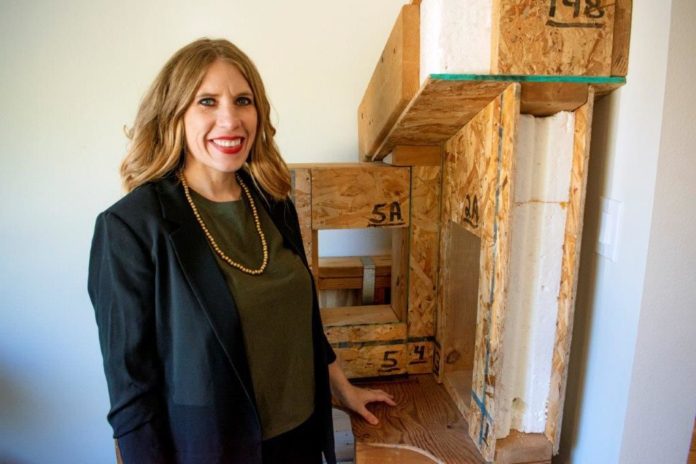Heather Ferrier Laminack is the fourth generation in her family to specialize in construction and the first woman to be named president of the Greater Fort Worth Builders Association.
How did she get there?
In 1882, a young stonemason from Scotland immigrated to the U.S. in search of better opportunities for his family. Alexander Ferrier’s occupational know-how landed him a job at the construction site of the Texas State Capitol, the largest of all domed state capitol buildings.
The craft he passed down to his offspring paved way for the establishment of a full-fledged business, Ferrier Custom Homes and Remodeling.
A lot has changed in the family business model since then.
The construction materials the company mostly uses switched from limestone and granite to sun-reflecting galvalume metal roofs and paints with low-volatile organic compounds. The focus is now in sustainability and high-performance homes.
Almost a century-and-a-half later, the Ferrier family legacy in construction is being carried on by the daughter, Laminack.
Laminack is laying the groundwork for present and future female aspirants in the popularly male-dominated field of construction and homebuilding.
And, she is getting the recognition, as when she was named the first female president in the 500-member GFWBA’s 75-year-old history.
Laminack was inducted as the president by Fort Worth Mayor Betsy Price in a celebration ceremony at The Ashton Depot late last month.
Now, she leads the executive committee of the association, comprised of about 500 members from developers, builders, subcontractors to architects, interior designers, lawyers and product manufacturer, among others.
The association also awarded Laminack the Builder of the Year title.
GFWBA serves the construction industry of seven North Texas counties, which includes Tarrant County.
Fort Worth Business Press talked with Laminack to learn more about the region’s construction trends and her new role.
GFWBA had its first female president in 75 years. What does this say about the construction industry?
It does show that things are changing. We have expectations of what gender or ethnicity certain traits are. Those barriers have been coming down for a while, and they definitely are now and it’s evolving.
We [women] are still a minor (part of the industry). But that’s growing and we’re seeing more and more of it. Hopefully, as we see more women rise up in the leadership within this industry, that will inspire the next generation.
What does it mean for you to be the president of GFWBA?
Being the first female, it’s a real honor. But the builder association has always been really welcoming. They’ve always offered a seat at the table for me. They’ve always been really encouraging of my participation. Even since I’ve been involved, we’ve had more woman rise up into leadership and so forth. It’s overdue, but the tide is changing.
Sometimes, it just has to be done once for someone to know it’s possible. And pretty soon, someone is surpassing those goals quickly. My goal is to be a disruptor, I guess, if you will in that way.
What was it like growing up in a family of homebuilders?
Not that different than the construction industry in general – very male-dominated. It was mainly men that were interested in going into construction in my family.
I never really envisioned myself being in the construction industry. I always connoted that with having a tool belt, being very handy. But as our focus changed in the early 2000s towards a more sustainable-minded approach and technology was changing… it became more interesting to me, professionally and personally. I got hooked.
Did the younger you ever felt any underlying pressure to follow and be involved in the family business?
Yeah. I kept thinking my parents would have another kid, and it’d be a boy and it’d solve the problem. But it’s just me and my sister, which is first time in our family lineage that a boy wasn’t there to take over, by default. I thought if I’m going to be invested in it, I want it to be something I’m proud of and not just going through the motions, but something that I believe in.
What is it like working in construction as a woman?
I’ve built and remodeled similar to the ethos of our company, kind-of walking the walk, too and not just talking the talk. Still, females are the minority, especially outside of the office. In general, I mean, I’ve found people to be really welcoming, with open arms. They just want to know that you’ll do a good job at the end of the day, both with trades and with the clients.
What do you consider a main challenge the construction industry currently faces?
Labor. I don’t have to explain how our industry is booming, how many people are people to Fort Worth in a day. We just have a lot of demand and not enough skilled labor. So, that raises prices – you know, supply and demand. I think, in North Texas, that’s our biggest challenges. Alongside of that is affordability – keeping homes affordable, so more people can buy them. It’s something like, a thousand dollar increase in home prices, a hundred thousand more people cannot afford that. We want to deliver quality products at a price that people can afford.
How are you tackling the problem?
We have probably about a dozen homes right now that are considered zero-energy homes. They produce, on average, as much energy as they consume.
Technology. Even using solar panels as an example, they get more efficient every six months or every year and it becomes more affordable. The technology gets better and more efficient, year after year. Then there’s the federal tax credit, the amount that you can get rebate for any renewable energy, is decreasing after this year. That’s another hurdle to get over. It’s always changing.






